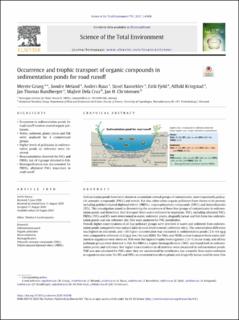| dc.description.abstract | Sedimentation ponds have been shown to accumulate several groups of contaminants, most importantly polycyclic aromatic compounds (PACs) and metals. But also, other urban organic pollutants have shown to be present, including polybrominated diphenyl ethers (PBDEs), organophosphate compounds (OPCs) and benzothiazoles (BTs). This investigation aimed at determining the occurrence of these four groups of contaminants in sedimentation ponds and determine their transport from water/sediment to organisms. PACs, including alkylated PACs, PBDEs; OPCs and BTs were determined in water, sediment, plants, dragonfly larvae and fish from two sedimentation ponds and one reference site. Fish were analysed for PAC metabolites. Overall, higher concentrations of all four pollutant groups were detected in water and sediment from sedimentation ponds compared to two natural lakes in rural environments (reference sites). The concentration difference was highest in sediments, and >20 higher concentration was measured in sedimentation ponds (3.6–4.4 ng/g ww) compared to reference (0.2 ng/g ww) for sum BDE6. For PACs and PBDEs a clear transport from water/sediment to organisms were observed. Fish were the highest trophic level organism (3.5–5) in our study, and all four pollutant groups were detected in fish. For PBDEs a trophic biomagnification (TMF) was found both in sedimentation ponds and reference, but higher concentrations in all matrices were measured in sedimentation ponds. TMF was not calculated for PACs since they are metabolised by vertebrates, but a transfer from water/sediment to organisms was seen. For BTs and OPCs, no consistent transfer to plants and dragonfly larvae could be seen. One OPC and two BTs were detected in fish, but only in fish from sedimentation ponds. It is therefore concluded that sedimentation ponds are hotspots for urban and traffic related contaminants, of which especially PACs and PBDEs are transferred to organisms living there. | en_US |

